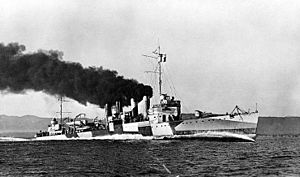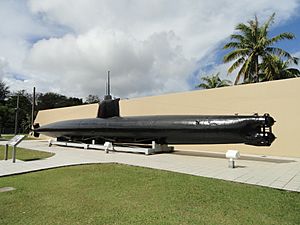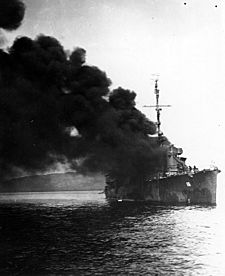USS Ward facts for kids

Ward in dazzle camouflage in 1918 (as DD-139)
|
|
Quick facts for kids History |
|
|---|---|
| Name | Ward |
| Namesake | James H. Ward |
| Builder | Mare Island Navy Yard |
| Laid down | 15 May 1918 |
| Launched | 1 June 1918 |
| Commissioned | 24 July 1918 |
| Decommissioned | 21 July 1921 |
| Recommissioned | 15 January 1941 |
| Reclassified | High-speed transport, APD-16, 6 February 1943 |
| Fate | Sunk by kamikaze 7 December 1944 |
| General characteristics | |
| Class and type | Wickes-class destroyer |
| Displacement | 1,247 long tons (1,267 t) |
| Length | 314 ft 4 in (95.8 m) |
| Beam | 30 ft 11 in (9.4 m) |
| Draft | 9 ft 10 in (3.0 m) |
| Propulsion |
|
| Speed | 35 knots (65 km/h; 40 mph) |
| Complement | 231 officers and enlisted |
| Armament |
|
The USS Ward was a special ship in the United States Navy. It started as a fast warship called a destroyer during World War I. Later, it was changed into a high speed transport ship during World War II. The Ward is famous for firing the first American shots in the Pacific during World War II. This happened when it attacked and sank a Japanese midget submarine right before the attack on Pearl Harbor.
Contents
Building a Warship: The USS Ward's Creation
The Ward was named after Commander James Harmon Ward. He was the first U.S. Navy officer to die in battle during the American Civil War. This ship was built very quickly at the Mare Island Naval Shipyard in California. It took only 17 and a half days to build! The ship was started on May 15, 1918. It was launched on June 1, and ready for duty on July 24, 1918. This speed was because destroyers were urgently needed for World War I.
The Ward's Journey: Service History
After it was built, the Ward moved to the Atlantic Ocean. In May 1919, it helped support the first flight across the Atlantic by Curtiss NC flying boats. A few months later, it returned to the Pacific. The ship stayed there until it was taken out of service in July 1921.
Back to Action: World War II Begins
When World War II started in Europe, the Ward was called back to duty. It was put back into service in January 1941. Soon after, the destroyer was sent to Pearl Harbor in Hawaii. For the next year, it patrolled the waters around Hawaii.
The First Shot: Pearl Harbor Attack
On the morning of December 7, 1941, the Ward was patrolling outside Pearl Harbor. Its commander was LCDR William W. Outerbridge. Around 3:57 AM, another ship, the Condor, signaled that it had seen a periscope. The Ward immediately started looking for it.
At about 6:37 AM, the Ward spotted a periscope following a cargo ship. The Ward attacked the target right away. It fired its guns and dropped depth charges. Even though it wasn't confirmed at the time, the Ward's guns hit a Japanese two-man Ko-hyoteki-class midget submarine.

The two crewmen on the submarine died. This was the first time Americans caused casualties in the Pacific part of World War II. This happened a few hours before Japanese planes attacked Pearl Harbor. The submarine was trying to sneak into the harbor by following the cargo ship through the anti-submarine nets. Since it entered American waters without permission, the Ward had the right to protect its territory.
For many years, people weren't sure if the Ward had really sunk a Japanese mini-sub. Some thought it might have been a false alarm. But on August 28, 2002, scientists from the University of Hawaii found the sunken submarine. The wreck was found about 1,200 ft (366 m) deep, about 3–4 mi (3–3 nmi; 5–6 km) outside Pearl Harbor. The submarine's conning tower had a shell hole, which was proof of the Ward's hit. The depth charges didn't cause much damage, but the hole from the gun caused the submarine to fill with water and sink.
After Pearl Harbor: New Missions
In 1942, the Ward went to the West Coast. It was changed into a high-speed transport ship. In February 1943, it was renamed APD-16. Then, it sailed to the South Pacific to work in the Solomon Islands.
The Ward helped fight off a big Japanese air attack near Tulagi on April 7, 1943. For most of that year, it helped escort other ships and transport troops. In December, it took part in the invasion of Cape Gloucester. During 1944, the Ward continued its escort and patrol duties. It also helped with several landings in the Southwest Pacific. These included landings at Saidor, Nissan Island, Emirau, Aitape, Biak, Cape Sansapor, and Morotai.
The End of the Ward: A Kamikaze Attack

As the war moved closer to Japan, the Ward was sent to help take back the Philippine Islands. On October 17, 1944, it dropped troops ashore on Dinagat Island. This was during the start of the Leyte invasion. For the rest of October and November, the Ward escorted ships to and from Leyte. In early December, it transported Army soldiers during landings at Ormoc Bay, Leyte.
On the morning of December 7, 1944, exactly three years after it fired the first shot at Pearl Harbor, the Ward was attacked. It was patrolling near the invasion area when several Japanese kamikazes attacked it. One bomber hit the ship in the middle, stopping it completely. The fires caused by the hit could not be put out. The crew of the Ward was ordered to leave the ship. It was then sunk by gunfire from the O'Brien. The commanding officer of the O'Brien was William W. Outerbridge. He had been the commander of the Ward during its famous action at Pearl Harbor three years earlier.
In early December 2017, the wreckage of the Ward was found by the RV Petrel. It was located 686 ft (209 m) underwater.
In the movie Tora! Tora! Tora!, the Ward was played by the USS Finch, which was an Edsall-class destroyer escort.
Awards and Recognition
The USS Ward received several awards for its service:
- World War I Victory Medal
- American Defense Service Medal with "FLEET" clasp
- Asiatic-Pacific Campaign Medal with nine battle stars
- World War II Victory Medal
- Philippine Liberation Medal with two stars
A Special Memorial
When the Ward was changed into a high-speed transport, its number-three 4"/50 caliber gun was removed. In 1958, this gun was placed as a memorial at the Minnesota State Capitol in St. Paul. The men who fired this gun on December 7, 1941, were members of the Minnesota Naval Reserve.
A plaque with the names of the naval reservists from St. Paul who served on the Ward is now in the St. Paul City Hall. It is on the third floor, near the council and mayoral offices. The ship's bell from the cruiser Saint Paul is also in this area. The last surviving member of the gun crew from that morning, Alan Sanford, passed away in January 2015.
As of 2012, no other ship in the United States Navy has been named Ward. However, sometimes people confuse it with the three destroyers named Aaron Ward.


